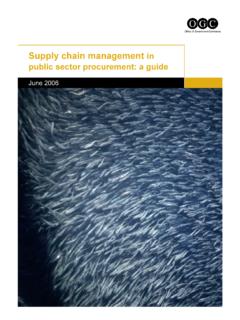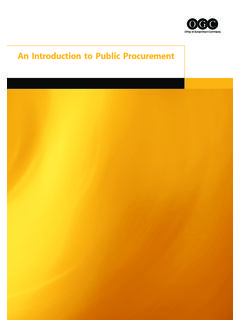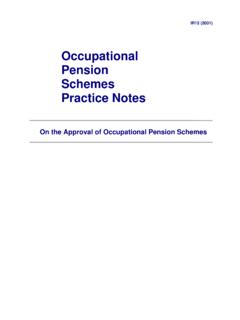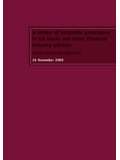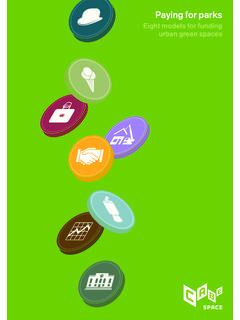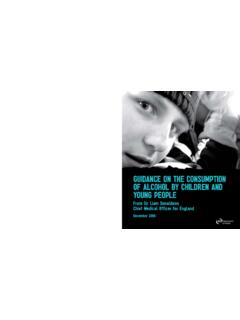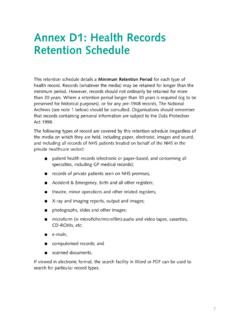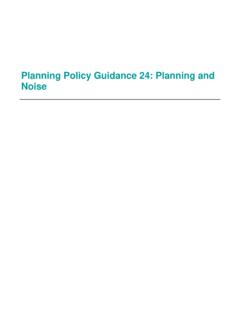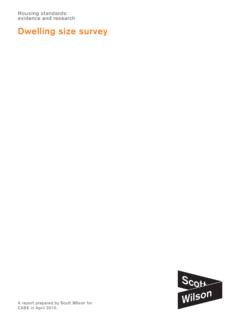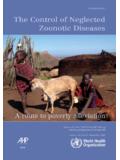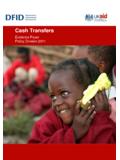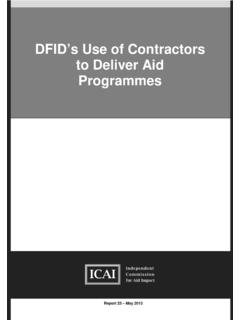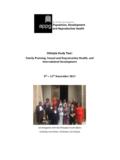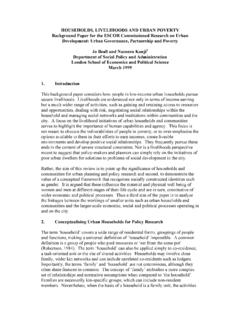Transcription of The causes of conflict in Africa: Consultation …
1 DFIDD epartment forInternationalDevelopmentThe causesof conflictin AfricaConsultation documentThe causes of conflict in AfricaPromoting poverty reduction, peace and stability in the world are key objectives of British Government policy. In July 2000the Government announced that the Foreign and Commonwealth Office, the department for international Developmentand the Ministry of Defence, in association with the Cabinet Office and HM Treasury, would work more closely togetherto improve the effectiveness of Britain s contribution to peace keeping, conflict prevention and conflict management inSub-Saharan africa and elsewhere in the draft paper examines the causes and consequences of conflict in africa . Its aim is to stimulate discussion andcontribute to Britain s longer term policy on tackling conflict in British Government would welcome any comments you may have on this paper by 30 April direct comments to: Resolving conflict in africa , africa Policy and Economics department , department for international development ,94 Victoria StreetLondonSW1E 5 JLUNITED KINGDOME-mail.
2 Sub-Committee on conflict Prevention in AfricaThe causes of conflict in africa Consultation document March 20013 Summary6 Part IThe background to conflict in Africa7 Emerging independence7 The Cold War7 The New World Order8 The current context of conflict8 Conventional warfare Wars of attrition8 Factional warfare8 Genocide and ethnic based conflict9 The New Warfare Regional conflict9 The impact of conflict10 The human tragedy10 The economic impact11 The costs of war12 Part IIThe causes of conflict13 Root causes13 Secondary causes14 Tertiary causes14 Part IIIR esponses to conflict16 Africa16 Regional16 International17 international and bilateral actions17 Part IVA comprehensive framework for conflict prevention in Africa20 The role of the UK21 Appendices234 The causes of conflict in africa Consultation document March 2001 ContentsDFIDD epartment for international DevelopmentDRCD emocratic Republic of CongoECOWASE conomic Community of West African StatesEUEuropean UnionFrelimoGoverning Political Party, MozambiqueG8 Group of Eight leading industrial nationsHIPCH ighly Indebted Poor CountriesIMFI nternational Monetary FundInterahamweHutu armed militia (Rwanda) MPLAP opular Movement for the Liberation of AngolaOAUO rganisation of African UnityOECDO rganisation for Economic Co-Operation and DevelopmentRUFR evolutionary United Front (Sierra Leone)SADCS outhern African development CommunityUNITAN ational Union for the Total Independence of AngolaGlossaryThe causes of conflict in africa Consultation document March 20015 conflict in africa Has dramatically increased in level and scalethroughout the 1990s.
3 In January 2000 over halfof African countries were affected. Is caused by inequality, economic decline, statecollapse and history. Has changed in nature; wars are now predominantlyregional. Has increasingly affected non-combatants over thepast decade as a result of increasing factional fightingand violent action against the civilian population. Has caused as many deaths each year as are caused byepidemic diseases, and has uprooted millions of people. Is constraining economic growth on the continent asa whole. Its economic impact crosses state borders. Has resulted in a marked reduction in food productionand serious losses of infrastructure. Must be tackled because of the human suffering andalso because of the impact on global security and theenvironment. Requires a stronger and more focused internationaleffort encompassing conflict prevention, reduction,resolution and peace building, in order to respondeffectively and break the conflict causes of conflict in africa Consultation document March 2001 The Background to conflict in AfricaEmerging birth of the OAU in 1963 heralded the beginningof the end of africa s colonial era.
4 At its inceptionOAU had 32 independent member arenow 53. From the beginning, the OAU recognisedthe imperfections of national boundaries. It madethe choice that, if africa was to remain stable, theboundaries that existed at independence should principle was enshrined in a 1964resolution and has remained OAU policy since a founding principle, the OAU signalled itsintention to to eradicate all forms of colonialism fromAfrica . Many African countries fought hard to gaintheir independence. In the former Portuguese colonies,the struggle was both lengthy and overthrowof the Salazar regime in the mid 1970s created a powervacuum. In Angola, the collapse of weak transitionalarrangements left three liberation movements inarmed competition. In Mozambique, Frelimo had onlypartially consolidated its authority in the North of thecountry when it found itself in power. Both countriesbecame victims of a cold war proxy confrontationand a South African campaign fought by the formerapartheid regime, which sought to destabilise the front line , most countries in africa went througha relatively smooth transition to to OAU principles guaranteed a high levelof national stability within the majorityof newly independent countries defined the role of thestate in development terms, seeking to harness nationalresources towards ensuring economic structures and institutions of the state, however,remained relatively undeveloped through the 1960s, thefocus being on building those institutions that allowedfor the exploitation and management of emerged an African leadership system.
5 Basedon centralisation of power and patronage networks thatallowed little popular involvement in government atnational or local Horn of africa was an Somalisnever accepted their externally imposed borders andfor decades unsuccessfully pursued the vision of agreater UN s acquiescence when Ethiopiaended the federation with Eritrea compounded theproblems of the continuing problems ofSudan also arise from failure to establish a politicalstructure that adequately reflects the real differencesof the inability to resolve these issues hassustained conflict at different levels of intensity overthe past thirty-five Cold Cold War led to the emergence of East-Westspheres of influence in africa . A system of client statesemerged, in which the leaders were maintained inpower in return for their allegiance to one of thesuperpowers. In countries such as Somalia, Zaire andSierra Leone a corrupt leadership was sustained whilethe institutional basis of the state continued to Horn of africa and Southern africa were ofparticular strategic interest to the great powers.
6 Armsflows and military expenditure increased dramaticallyin these two regions during the Cold majorpowers and their allies were actively engaged inmilitary training and a number of foreign forcesincluding the Cubans and the Chinese had asubstantial presence on the war interests directly fuelled two major 1975, South africa intervened in Angola to preventthe MPLA coming to MPLA were seenas a communist surrogate, a perception that wasreinforced by the arrival of 12,000 Cuban troops tosupport the perceived communist threatto Southern africa intensified the conflict and reducedWestern pressure on apartheid South africa . In 1977,Somalia had built up sufficient military strength toattack Ethiopia in the Ogaden region. Ethiopian forces,with considerable Cuban assistance, repulsed theoffensive. Soviet Bloc support to Ethiopia sustainedand prolonged conflict throughout the region duringthe this era the scale of conflict was no greater thanwas being experienced in Asia.
7 Aid flows remained highbecause the major powers were motivated to ensurethe continuing support of client states. But there wasa conflict did erupt, strong centralisedgovernments enforced their authority through largePart IThe causes of conflict in africa Consultation document March 20017standing same armies were to become athreat to stability in africa once external support waswithdrawn. At the end of the Cold War, there was littleeffective demobilisation in africa and the remnantsof large African armies still remain in the continent,contributing to new areas of conflict or sustainingfactional irregular armed groups which threaten bothdomestic stability and the Cold War state-to-state arms transfersinvolved primarily heavy, high maintenance equipment tanks, transport aircraft and jet scale wascolossal. In 1988 alone, at the end of the Cold War, theyamounted to more than $4 billion. By 1995, they haddropped to $270 million. However, state to state flowswere replaced by a major growth in commercial armsdealing and illegal arms trafficking in low maintenancelight weaponry, primarily items such as the AK 47 rifleand rocket propelled grenade launchers.
8 (See alsoparagraphs 45 and 64.)The New World 1990, the Secretary General of the OAU presenteda report to his Council of Ministers on the changestaking place in the world and their implications forAfrica. In this he stated that the strongest likelihooddoes exist for the emergence of a new geopoliticalbalance of forces as well as a new internationaleconomic order that could further debilitate andmarginalise africa . 1 These fears were well became more widespread through the economic management weakened highlycentralised inability to provide basic levelsof policing and social services helped to lead to theweakening of state authority. Internal conflict increaseddramatically throughout the 1990s. In extreme cases,fragmentation encouraged the formation andproliferation of splinter groups, which in turn dividedinto warring very nature of civilian population increasingly becamethe target of conflict in factional wars and subjected toparticularly high levels of violence and in massive displacement as well as social andeconomic levels of ethnic violence and genocide, aswitnessed in Rwanda and Burundi, re-emerged in thelast decade of the political exploitation ofethnic discrimination in africa has its roots in colonialhistory.
9 In general, it is more often used as a means tosustain conflict and is rarely a primary , theincreasing marginalisation of the poor has providedfertile ground for those promoting ethnic conflict asa means of sustaining their own control over violence is now becoming part of the cultureof conflict in a number of ailing, autocratic leaders in africa lostcontrol and external support, several states states such as Liberia, Somalia, Sierra Leone andZaire became centres of regional insecurity. Africancountries increasingly intervened militarily inneighbouring states and justified their actions on thegrounds of necessary self protection. conflict becameincreasingly regional in nature as collapsed statesthreatened the security of their 2000, over half the countries in africa and 20% ofthe population were affected by wereeleven major conflicts with more than a thousand warrelated deaths a extent of conflict was greaterthan in any other region in the Current Context of distinct types of conflict are now warfare wars of conflict between Ethiopia and Eritrea was theonly conventionally fought war in africa during thelast decade.
10 It was fought with regular troops alonga defined series of and objectives wereprimarily military and war madeextensive use of expensive technology such as heavyartillery and jet increasing cost of suchwarfare has tended to make these conflicts self-limitingin wars are fluid by is rarelya defined front line and fighting is frequentlyopportunistic rather than is low techand small arms are the main weapons. Such wars arenot costly and can easily be sustained without externalsupport. Frequently these conflicts move rapidly fromthe original cause to revolve around the exploitation ofcommercial, mineral and natural I: The background to conflict in Africa8 The causes of conflict in africa Consultation document March 20011 Report of the Secretary General on the fundamental changes taking place in the world and their implications for africa : Proposals for an African response.(Fifty second ordinary session of the Council of Ministers).
